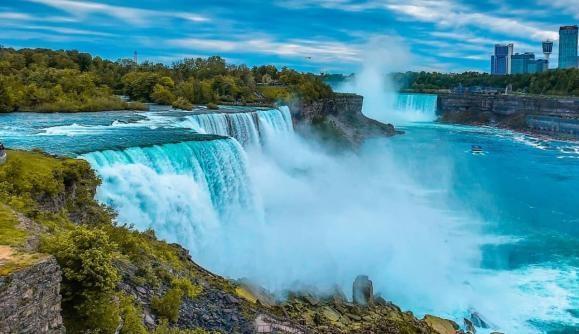Waiyapot ep080 Geology of Silurian Period ลักษณะธรณีวิทยา ของยุค ไซลูเรียน

Fig 80.1 carbonate rocks of Niagara fall north America. (Silurian Period).
EP. 80 Geology of Silurian Period ลักษณะธรณีวิทยา ของยุค ไซลูเรียน
ทวีป Laurentia, Baltica, Siberia, และภาคเหนือของ Gondwana วางตัวอยู่ใกล้เส้นศูนย์สูตร โดยมีทะเลตื้นล้อมรอบ ทำให้เกิดการสะสมตัวของหินชั้นหนาในทะเลตื้นเป็นแอ่งสะสมตะกอน (sedimentary basins) จำนวนมาก หินที่พบจะเป็นหินชั้น molasse types sedimentary rocks จำพวก clastic sediments ได้แก่หินดินดาน หินทราย และหินทรายแป้ง โดยมีชั้นหิน conglomerate ที่เป็น unconformity ที่แบ่งหิน Ordovician จากหิน Silurian การเกิดทะเลตื้นที่กว้างขวางทำให้เกิดแนว coral reef ที่เกิดจาก corals แบบ tabulate and rugose corals และ stromatoporoids (sponge-like organisms) เป็นครั้งแรกในโลก ทำให้เกิด carbonate platform ขนาดใหญ่ เช่นแนวหิน carbonate ที่รองรับ แนวน้ำตกในแองกาลา ในทะเลสาบ มิชิแกน ชายแดน อเมริกากับแคนาดา ในขณะที่บนพื้นทวีปมีการสะสมตะกอนจากแม่น้ำ (terrestrial sedimentary rocks, red bed) แบบ fluvial types, deltaic types, และ lacustrine types, ตัวอย่างของชุดหิน carbonate ของหิน Silurian ได้แก่ The Niagaran reefs in North America และ the Wenlock Limestone in the UK., the Gotland Island in Sweden, the Michigan Basin in North America, organic-rich black shales ใน north Africa and the Arabian Peninsula, เป็นต้น
.
-------------------------
ที่มา
- https://www.facebook.com/weerasak.phomthong
รวบรวมข้อมูลและภาพ
-------------------------
บทความ ไวยพจน์ วรกนก (Waiyapot Worakanok) รวมข้อมูล
รวมบทความที่น่าสนใจจากนักธรณีวิทยาของไทย
-------------------------
